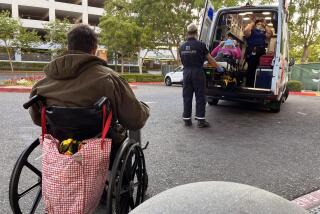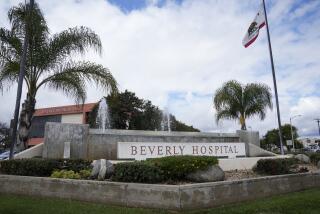Ailing Trauma Network on the Verge of Collapse
The network of hospitals in Los Angeles County that provides emergency trauma care to 16,000 patients annually is once again in critical condition, with some of the 13 centers saying that their survival is threatened.
The private hospitals that treat victims of freeway accidents and gunshots and handle other emergencies face a serious shortage of money at a time when neither private insurance companies nor governments are eager to pay for an expensive--although vital--level of medical care.
“The county thinks the state should pay, the state thinks the county should pay, and both think the Feds should intercede,” said Dr. Don Gaspard, medical director of trauma service at Huntington Memorial Hospital in Pasadena. “It’s a three-ring circus.”
Five private hospitals have notified the county that they may close their trauma operations, according to county officials. Officials at two of those hospitals--Henry Mayo Newhall Memorial Hospital in Valencia and Providence Holy Cross Medical Center in Mission Hills--backed away from those threats Thursday, saying that they will not close. Another--Childrens Hospital Los Angeles--said it would consider closing only if others did first.
Administrators at Huntington Memorial and Northridge Hospital Medical Center said they do not want to close but will consider it if the financial picture does not improve.
The crisis here is the most visible symptom of nationwide traumas in health care: Hospitals and doctors are being battered as private insurers and government programs cut back their health care payments. Simultaneously, the number of patients without insurance has risen steadily.
In California, trauma systems everywhere are severely strained. Hospitals in general are in a precarious state, with more than 60% operating in the red. Doctors balk at taking money-losing emergency calls at the expense of already ailing private practices.
“The infrastructure, in my opinion, is crumbling,” said Gary Stephany, president of a hospital trade group in San Diego and Imperial counties. “I think the whole health care system is in a meltdown--it’s not just trauma.”
Not so in Orange County, which has managed so far to keep its emergency trauma system healthy.
“Orange County, luckily, is stable,” said Dr. Bruce Haynes, medical director for the county’s emergency medical services. The system’s three trauma centers serve about 3,500 patients a year.
Haynes could not say exactly how or why the county had avoided the problems of Los Angeles. “We have hospitals that have a long history of providing trauma care,” he said, “and they are committed and continue to be very interested in taking care of injured patients.”
He and other county leaders will attend a meeting in Los Angeles soon, he said, to learn more about the trauma center woes there.
In most areas, trauma is the most dramatic example of the health-care system’s broader problems. That is especially true in Los Angeles County, which has one of the highest proportions of uninsured people in the nation, enormous market dominance by managed care companies and a sprawling territory to serve. Eleven trauma centers have closed in the last 15 years. Any further unraveling of the fragile system could mean dangerously long delays in treating patients.
“The bottom line is . . . people will die,” said Jim Lott, executive vice president of the Healthcare Assn. of Southern California.
Trauma centers are hospitals that keep expert surgeons and specialists on hand around the clock to serve as the primary destinations for paramedics carrying patients with life-threatening or severe injuries.
Struggling to Preserve System
In a sprawling area such as Los Angeles, each center in the trauma network is vital. Even a few minutes tacked onto an ambulance ride can mean the death of a critically injured patient.
All summer, county officials have been struggling to keep the system intact. The county supervisors are scheduled to consider solutions in the next several weeks--and will hold a public hearing on the problem on Monday--but few believe the county, which is cursed with unreliable revenues, can fix the problem alone.
“We need a cure, not a Band-Aid,” said Supervisor Mike Antonovich. “It’s a vital health program that needs to be strengthened, not weakened. Right now it’s on life-support.”
The trauma system in Los Angeles County consists of 10 private, nonprofit hospitals and three county hospitals. The linchpin of the entire system is County-USC Medical Center in Boyle Heights.
A decade ago, the county spent $9 million a year to help private hospitals pay for the care of the uninsured patients who make up 30% to 40% of those in the trauma system. But the amount of money has declined steadily, and this year is only $1.5 million.
The cutbacks have put the private trauma centers under considerable strain. Even if only one closes, it could have devastating effects on the centers that stay open, because patients who would have gone to the closed hospital will be routed to the others, jacking up costs still further.
“It’s like a deck of cards or dominoes,” said Carol Gunter, assistant director of the county’s Emergency Medical Services Agency. “You line them up and they’re all going to go.”
If Huntington Memorial were to shut down its trauma services, for example, as many as 800 trauma patients a year from the eastern part of the county would have to rely on County-USC, which is already overtaxed.
“I’m not trying to be sensationalist here,” said Dr. Demetrios Demetriades, trauma chief at County-USC. But should Huntington’s patients be routed to County-USC, “a lot of severely injured patients from the east San Gabriel Valley will die on their way to the hospital.”
Other California counties are watching closely to see if Los Angeles can fix its troubled system, said Leonard Inch, regional executive director for the Sierra-Sacramento Valley Emergency Medical Services Agency, which oversees trauma care in five counties.
“Where L.A. goes, the rest of the state will follow,” he said.
*
Times medical writer Julie Marquis and Times staff writer David Haldane contributed to this report.
(BEGIN TEXT OF INFOBOX / INFOGRAPHIC)
Trauma Network
Health officials are worried about the future of the network of 13 trauma centers that are the primary destinations for anyone severely injured in Los Angeles County.
Source: L.A. County Department of Health Services
More to Read
Sign up for Essential California
The most important California stories and recommendations in your inbox every morning.
You may occasionally receive promotional content from the Los Angeles Times.










